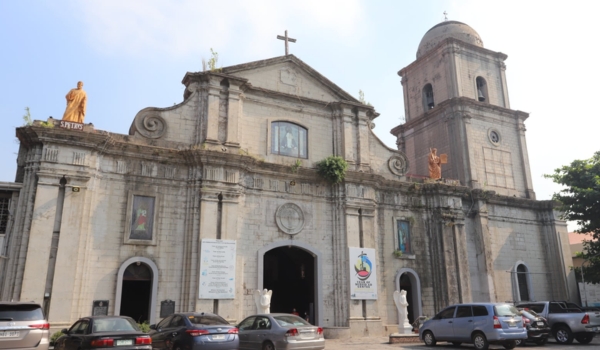
Cavite Mutiny of 1872 by workers in Cavite arsenal against Spanish rule - led to the martyrdom of Filipino priests Fathers Jose Burgos, Mariano Gomez, Jacinto Zamora, who were fighting for the issue of secularization. They were implicated in the mutiny, tried by a farcical court and executed on February 17, 1872 in Bagumbayan, now Luneta.
Proclamation of independence in Kawit on June 12, 1898 at the residence of General Emilio Aguinaldo, president of the revolutionary government and first President of the Republic that would be inaugurated on January 23, 1899 in Malolos, Bulacan. At the Kawit event, the Philippine flag was raised and the national anthem was played for the first time. The flag was sewn by Marcella Agoncillo, wife of a revolutionary, on request of General Aguinaldo. History of the Diocese from CBCP Website
The Catholic faith first came to Imus in 1571. Among the religious orders that Christianized the Cavitenos were the Franciscans, the Recollects, the Dominicans and the Jesuits.They established their first center of faith in Cavite (now Cavite City), then in Silang in 1581, in Kawit in 1587, in Maragondon in 1611, Indang in 1655, Ternate in 1700 and in San Francisco de Malabon (now General Trias) in 1758.Through the zeal of the first missionaries of faith spread fast in the area. The missionaries also helped in the founding of most of the towns in Cavite. As early as 1614 Cavite became a politico-military province.
The province of Cavite is rich with historical significance. It had been the site of many battles and uprisings against Spain, one of which was that of 1872, which resulted in the execution of three priests: Gomez, Burgos and Zamora. Cavite is also where General Emilio Aguinaldo proclaimed the First Philippine Republic on June 12, 1898, in Kawit.
The province is named after its shape, that of a hook - hence Kawit, meaning hook, in Tagalog. It is geographically situated at the very entrance to Manila Bay, a location which has made it, along with Bataan on the north, the scene of many battles in the past. It is bounded on the northwest by the Bay, on the northeast by the provinces of Rizal and Laguna, on the southwest by the province of Batangas. Its capital city is Trece Martires.
Early in the American regime a U.S. naval garrison was stationed at Sangley Point in Cavite after civil government was established in 1901. Because of mutual defense agreements, this base remained in Cavite long after the country was granted its independence in 1946.
The topography of the province is rather flat, so rice is an important crop. Fishing is another major industry, taking into account its coastal waters. The language spoken is Tagalog, now the national language of the country. More than 60 percent of the inhabitants live in urbanized areas because of its proximity to Manila. Today Cavite is witnessing a more radical urbanization as factories, subdivisions, golf courses, resorts and an export processing zone (EPZA) have sprung up in the province. Tagaytay City, with its cool climate and a scenic view of Taal Law and Taal Volcano draws many tourists each year.
The Diocese of Imus was created on Nov. 12, 1961, and erected on April 26, 1962. Its titular patron is Nuestra Senora del Pilar. The diocese is a suffragan of the Archdiocese of Manila.
The same as all over Philippines. The province is led by the local executive branch: provincial governor, city and town mayors and vice-mayors, with local boards/councils. The smallest political unit is a barangay, headed by a captain assisted by a barangay council. In the local legislative branch: one congressman per congressional district (4 districts in Batangas). The local judicial branch comprises regional and provincial courts.
The diocese has a land area of 1,287.6 square kilometers. It comprises the entire civil province of Cavite. Uplands begin from Carmona and Silang towns going south all the way to Maragondon (Alfonso, General Trias, Magallanes, etc.), with Tagaytay Ridge having the highest elevation at 640 meters. The Ridge overlooks Batangas' Taal Lake.
Demographic data
It serves a total population of 2,690,085, mostly Catholics. There are no significant ethnic groups. Languages used are English and Filipino.
Cavite belongs to CALABARZON, or Region IV-A. The average family income in the region is 184,000 pesos per year according to the National Statistics Office (NSO) Income and Employment Division. Data as of 2003. Cavite is host to many large and medium-scale manufacturing facilities, especially of semiconductors and food processing which serve both domestic and export markets. Fishing and farming are the main sources of livelihood. Main crops produced are coffee, pineapple, corn and vegetables.
Similar to Metro Manila, Globe, Smart cellular networks and the Philippine Long Distance Telephone companies provide telephone and internet connections. Radio, cable and regular television networks are accessible province-wide.
Transportation facilities are similar to Metro Manila, using jeepneys, mini-buses and tricycles. Most people still use in traveling to and from adjoining areas and Manila, jeepneys, air-conditioned vans, buses both air-conditioned and regular are available. Those opting for convenience or a cheaper alternative to driving their own vehicles use air-con vans and similar vehicles that operate "FX" (cab) style: with terminals in such Cavite towns as Imus, Carmona, Dasmarinas, filling up with passengers before leaving the terminal, and charging a fixed fee which is almost three time regular fare. Terminals, both in Cavite and Metro Manila are strategically located in commercial and centers and pass through places of high commuter density such as Baclaran and Lawton. Similar systems operate in Batangas and Laguna.
The Region IV-A simple literacy rate is 97.2 percent and functional literacy rate is 90.4 percent based on 2003 records of the NSO Demographic and Social Statistics Division.